 полная версия
полная версияThe Mentor: Rembrandt, Vol. 4, Num. 20, Serial No. 120, December 1, 1916

John C. Van Dyke
The Mentor: Rembrandt, Vol. 4, Num. 20, Serial No. 120, December 1, 1916
Christmas Giving

The old question – What shall we give? Too often answered by giving the easiest thing. “There, that’s off my mind for another year!” Yes, off your mind – but how does your heart feel when your friend sends you something that shows that he has cherished a little special thought of you?

Christmas giving may be a blessing or a blight – according to the spirit of the giver. It is a blessing when it carries with it a thought that honors the one that gives and benefits the one that receives.

“Benefit is the end of Nature,” says Emerson, “and he is great who confers the most benefits. Beware of good staying in your hand. Pay it away quickly to someone.”

Thousands of you tell me in the daily mail how The Mentor benefits you. Can you give a better gift to your friend than this same benefit? If we benefit you, we can also benefit him. With whole heart we pledge full service to him as to you. Give, then, this Christmas, The Mentor and all its service to your friend. Your message of friendship will be repeated to him twice a month throughout the year.
THE EDITOR.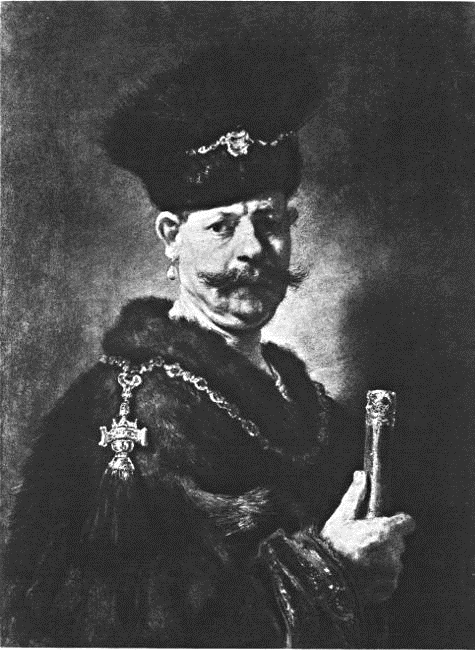
IN THE HERMITAGE, PETROGRAD
SOBIESKI – Portrait by Rembrandt
REMBRANDT
Early Years
ONESometimes it is difficult to learn the truth about a great man. This is particularly so in the case of one who lived three centuries ago; for in those days people were not as careful to keep records as they are today. For years the great painter Rembrandt was regarded as having been ignorant, boorish, and avaricious. Fables making him out to be such a character sprang up without any foundation. It is only within the last fifty years that we have come to know the true Rembrandt, and to realize that he had profound sympathy, a powerful imagination, and originality of mind, and that he was a poet as well as a painter, an idealist and also a realist. He has justly been called “the Shakespeare of Holland.”
Rembrandt Harmens van Rijn – for that is his full name – was born at Leyden, a town near Amsterdam, in Holland, on July 15, 1605. Leyden is famous in history as the birthplace of many great artists and other men of renown. Rembrandt’s home overlooked the river Rhine. He was the son of a well-to-do miller, and his parents were ambitious that Rembrandt enter the law, for his older brothers had been sent into trade.
At that time Holland was entering upon her great career of national enterprise. Science and literature flourished, poetry and the stage were cultivated by her people, and art was made welcome in every town, large and small. So Rembrandt, after he had been sent to the high school at Leyden, decided to become a painter. For already within him he felt the first urgings of genius.
Accordingly, when Rembrandt was only twelve or thirteen years old, his father allowed him to become a pupil of Jacob van Swanenburch, a painter of no great ability, who, however, enjoyed some reputation because he had studied in Italy. Three years later the boy was placed under Pieter Lastman, of Amsterdam, who was a much better artist and teacher. Authorities differ as to how long Rembrandt remained with Lastman. One says that he was his pupil until he was nineteen years old; another believes that he studied with him for only six months. At any rate, sometime after 1623 Rembrandt returned to the home of his parents at Leyden.
During these first years of his artistic life, Rembrandt worked hard. He painted pictures of almost everyone he saw – beggars, cripples, and in short every picturesque face and form of which he could get hold. Life, character, and special lighting effects were his principal concern. Frequently he used his mother for a model, and from these portraits we can trace his strong resemblance to her. The young artist also liked to paint his father and sisters; and by the number of portraits he painted of himself, we can see that from the very beginning he worked hard to master every form of expression, learning to draw the human face as it appeared not only to the casual observer, but also to one who read the character within. It is said that during his lifetime Rembrandt painted nearly sixty portraits of himself.
Time went by, and the young artist of Leyden was attracting the attention of art lovers in the great metropolis of Amsterdam. Some of them urged him to move there; and feeling that he was now strong enough to stand alone, Rembrandt rented a large house in Amsterdam and removed there in 1631. He divided the upper part of his house into small studios, and there he worked and taught. His pupils were many and from wealthy families. From this teaching Rembrandt derived a large income.
Fortune smiled upon him. At one bound he leaped into the position of the leading portrait painter of Amsterdam. Numerous commissions for portraits flowed in upon him, and during the first few years of his residence there he painted at least forty. When he was only twenty-six years old, in 1632, he painted the “Anatomy Lesson,” a picture that made an enormous sensation, and holds its place today as one of Rembrandt’s masterpieces.
The year 1634 was one of the happiest in Rembrandt’s life. He was then at the beginning of a successful artistic career, and it was at that time that he married Saskia van Ulenburg, a beautiful Frisian maiden. Saskia brought him love and wealth. Eight years of prosperity and sunshine followed their union.
Rembrandt and his wife were a joyous pair. They had four children, a boy and two girls who died in infancy – and a son, Titus, who grew to man’s estate.
PREPARED BY THE EDITORIAL STAFF OF THE MENTOR ASSOCIATIONILLUSTRATION FOR THE MENTOR, VOL. 4, No. 20, SERIAL No. 120COPYRIGHT, 1916, BY THE MENTOR ASSOCIATION, INC
DETAIL OF THE ANATOMY LESSON
By Rembrandt
IN THE HAGUE MUSEUM
REMBRANDT
The Master Painter
TWOThe year 1640 marks the beginning of what may be termed the second period of Rembrandt’s life and work. It was during these years that success and happiness were his. From then until 1654 Rembrandt worked in what has been called his “second manner.” His art grew in power, and the coldness of his “first manner” had disappeared. He had passed through a period of exaggerated expression and had come to a truer, calmer form of painting. It is interesting to compare his own portrait painted in 1640 with the earlier portraits of himself. This painting portrays a man strong and robust, with powerful head, determined chin, and keen, penetrating eyes. This was the Rembrandt of that period, the man confidently independent and careless as to his popularity as an artist.
Rembrandt had now many pupils. He had bought a house in Amsterdam, and had placed in it a great collection of paintings and engravings. At that time the artist was living a life of simple domesticity, happy with his wife and children. His friends were many, and his interests were large.
Rembrandt’s mother died in 1640, and two years later the great sorrow of his life came upon him. His wife Saskia died. This changed everything for him. The events of his latter days are clouded in obscurity.
The terms of Saskia’s will are interesting, in that they may throw some light upon a later action of the artist’s, which will be related further on. She left her money to their son Titus, with Rembrandt as sole trustee, and with full use of the money until he should marry again or until the marriage of Titus.
It was in 1642 also that Rembrandt painted his most famous picture – the “Night Watch.” This is one of the landmarks of Rembrandt’s career. However, it is not a night watch at all, but a call to arms by day, and more properly should be named the “Day Watch.”
The artist’s life was changed after the death of his wife. No longer does he appear to have been the buoyant, carefree painter and art lover. There is a pathetic sadness in many of his works done at this time. This is well illustrated in his pictures of the Holy Family, a subject which was a favorite with him during this period of his life.
One reason for Rembrandt’s unhappiness was his waning popularity. The “Night Watch,” which was painted to order as a collection of portraits in one composition, did not prove satisfactory to his customers. Some of them complained of being put in the background and obscured. Naturally, the artist could not give places of prominence to every person in the picture. Not understanding this, however, these people took offence at his disposition of the characters, and transferred their patronage elsewhere.
It was at this time that Rembrandt did a great deal of landscape painting, and genius that he was, he made a success of it. It is to this period that the famous painting, “The Mill,” is ascribed.
But though he was still the great artist, a cloud of adversity was slowly coming over Rembrandt’s life. Evil days were at hand.
PREPARED BY THE EDITORIAL STAFF OF THE MENTOR ASSOCIATIONILLUSTRATION FOR THE MENTOR, VOL. 4, No. 20, SERIAL No. 120COPYRIGHT, 1916, BY THE MENTOR ASSOCIATION, INC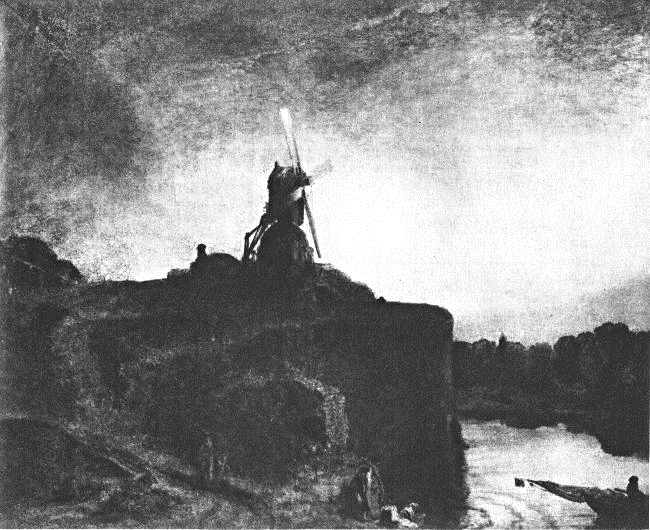
IN THE WIDENER COLLECTION, PHILADELPHIA
THE MILL, By Rembrandt
REMBRANDT
Last Years
THREEDuring the last part of the seventeenth century money was scarce in Holland. Long continued wars and civil troubles had worn out the country. Financial depression overwhelmed Amsterdam; and in addition to this the taste in art changed, and Rembrandt and his pictures were neglected.
Most of Rembrandt’s money was tied up in his house and in his large collection of valuable pictures; and when his paintings ceased to be in demand, he was forced to borrow money. Very little is known of the artist’s life at this time. He was living with his servant, Hendrickje Stoffels, and in 1654 a child was born to them. To her Rembrandt gave the name of Cornelia, after his much loved mother. It has been asserted that he married Hendrickje, but it is probable that he did not, for in such a case the money left by Saskia would have gone at once to her son Titus, according to the will.
In 1656 Rembrandt’s financial affairs went crashing down to ruin. By a process of law his house and land were transferred to Titus. But as his son was still a minor, Rembrandt was allowed to remain in charge of Saskia’s estate. And then ruin stared him in the face. In July, 1656, Rembrandt was declared bankrupt, and an inventory of his property was ordered. Two years later the larger part of his collection of etchings and drawings was sold. The sum realized was only a small fraction of their value.
Rembrandt, driven from his house, stripped of everything he possessed, without friends or money, took a modest lodging in Amsterdam. The city which once had acclaimed him as its greatest portrait painter now passed him by and left him alone to wait for death.
During all these dark years, however, Rembrandt was painting some of his greatest pictures. Even amid the ruins of his affairs he could go calmly on working; and for this he deserves the highest respect. Among the works of this time are the portrait of Jan Six, the “Adoration of the Magi,” and “John the Baptist Preaching in the Wilderness.” At the same time he continued to paint his own portrait; but in these pictures of the artist in his old age we see a man broken by misfortune.
Titus, Rembrandt’s only son, had married. He died in 1668, leaving one child. A year later, on October 8, 1669, Rembrandt himself passed away. In the “Livre Mortuaire” of the Wester Kerk in Amsterdam appears the following simple entry, relating to his death: “Tuesday, 8th Oct., 1669, Rembrandt van Rijn, Painter on the Rovzegraft, opposite the Doolhof. Leaves two children.”
Rembrandt outlived his popularity, although he was the greatest genius of his time and country, and in fact one of the great geniuses of all time and all countries. He was left to die alone and neglected by his fellow-countrymen, who had they foreseen the fame that the future held in store for him, might have sought his humble lodging to honor him on bended knee.
PREPARED BY THE EDITORIAL STAFF OF THE MENTOR ASSOCIATIONILLUSTRATION FOR THE MENTOR, VOL. 4, No. 20, SERIAL No. 120COPYRIGHT, 1916, BY THE MENTOR ASSOCIATION, INC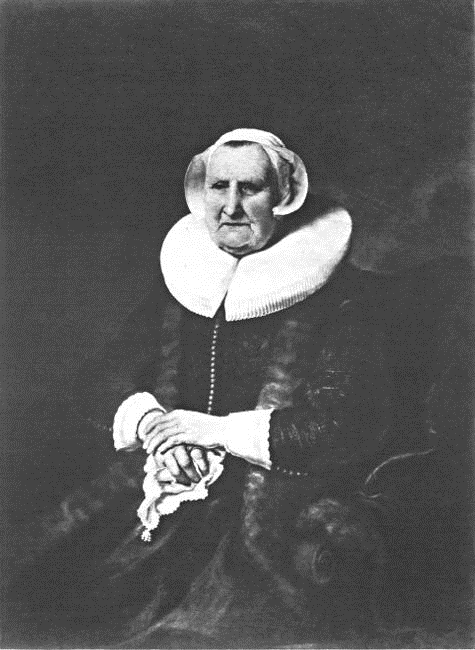
IN THE RYKS MUSEUM, AMSTERDAM
ELIZABETH BAS – Portrait by Rembrandt
REMBRANDT
The Real Man
FOUROne day Rembrandt was employed in painting the portraits of a very rich family in Amsterdam. This was to be a group picture, and as usual with him, Rembrandt was working hard to make it a success. While he was painting, someone opened the door of the room in which he was and brought in the dead body of a monkey. The appearance of this funny little creature appealed to the artist at once. He wanted to make a picture of it right away. But the only thing on which he could make the drawing was the canvas on which he was painting the portraits of the rich family. So Rembrandt, without hesitation, painted the monkey in among their portraits. They were very angry, of course, but in those days Rembrandt was at the height of his career and he did not have to concern himself about how his customers felt.
This little incident, whether it is strictly true or not, illustrates one side of Rembrandt’s character. When he was most successful he was carefree and independent. It may have been this independence that brought him to his ruin – although in all probability it was the indifference of his fellow citizens to his work.
The age in which Rembrandt lived cared little for personalities. There were no newspapers to record his doings, and no one of his contemporaries cared enough about it to write down much about his life and work. For these reasons, the world has never known much about Rembrandt, the man. We know that he was light-hearted, headstrong and extravagant. We know that he was neglected and died poor and feeble. But we know little more than this, although of late more reliable information concerning the life of this great painter has been found.
A man’s faults are usually remembered when his virtues are forgotten. For years it pleased biographers to represent Rembrandt as a ne’er-do-well artist, who could not take advantage of his opportunities. We know now, however, that his faults were very human ones, and that his merits greatly overbalanced them.
As a boy the artist was not an industrious scholar. He looked upon reading and writing as rather troublesome and hardly worth the labor involved in learning them. Later he worked hard at his chosen career, and the great number of pictures that he painted is sufficient evidence that he was by no means lazy.
Probably Rembrandt’s greatest fault was his extravagance. Many a man can endure adversity with courage; success is sometimes more difficult to bear. Hard luck often brings out the best in a man; success may destroy it. Rembrandt was no exception. He spent his money freely, and like the grasshopper of the fable, sang happily through the summer, with no thought of the cold to come.
He liked to attend sales of works of art, and he gladly paid huge sums for any pictures that caught his fancy. It is said that the dealers came very soon to know his rash and reckless methods and would push the prices far up, confident that Rembrandt would meet them. At the same time, the artist liked to buy expensive jewels for his wife. He loved Saskia devotedly, and he wanted her to have everything of the finest. This manner of open-handed living naturally played havoc with his finances.
When Saskia died Rembrandt was heartbroken. His customers fell off and many troubles overwhelmed him. His friends helped him as much as possible, but money ran through his hands like water through a sieve, and he could not seem to control his expenditures. Then later the death of his faithful Hendrickje was the last blow to his happiness. For a few years Rembrandt lingered, and then he too passed into the great silence.
It is true that many of Rembrandt’s troubles were self-inflicted: but he suffered enough to pay for his faults. At any rate it is better to remember him as a great genius and a man worthy of respect and honor.
PREPARED BY THE EDITORIAL STAFF OF THE MENTOR ASSOCIATIONILLUSTRATION FOR THE MENTOR, VOL. 4, No. 20, SERIAL No. 120COPYRIGHT, 1916, BY THE MENTOR ASSOCIATION, INC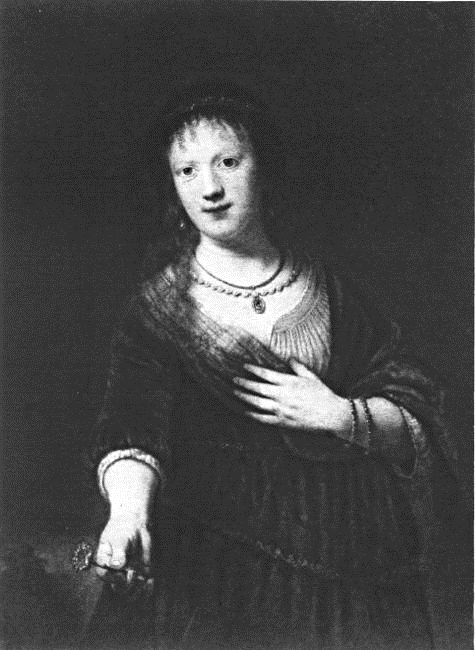
IN THE DRESDEN GALLERY
SASKIA HOLDING A FLOWER – Portrait by Rembrandt
REMBRANDT
Saskia van Ulenburg
FIVERembrandt’s life was one of curious contrasts. During his early manhood he was Amsterdam’s leading portrait painter. These were years of happiness and carefree enjoyment of all the good things of life. But almost as suddenly as the painter stepped into the sunshine of success, he fell back into the shadows of adversity. One of the principal causes of his happiness was his wife, Saskia. Just as her entrance into his life coincided with the period of his greatest prosperity, so her death marked the beginning of his darker years. It would seem almost as though Saskia were his guardian angel, and that with her departure Rembrandt’s star began to descend.
Saskia van Ulenburg was the ninth child of a wealthy patrician family of Friesland. She was born at Leeuwarden in 1612. Saskia became an orphan at an early age, and then she made her home with one or the other of her married sisters in turn, and finally with a cousin, who lived in Amsterdam. It was at the house of this cousin that Rembrandt met her. Charmed by her youthful grace, he obtained permission to paint several portraits of her.
Saskia at this time was a slender girl, rather small of stature. Her features were very regular, and her eyes were of a beautiful brown shade, matching her soft reddish brown hair. Her brilliant complexion was the envy of her less favored companions.
The young painter soon showed that he took a special interest in Saskia. He bestowed great care on her portraits, and was in her company as much as possible. He himself was young, attractive, and good looking; and we may be sure that Saskia’s family did not frown upon his suit. They probably realized that Rembrandt would make an excellent husband for their ward.
Rembrandt’s father had died some time before this, and his mother gladly gave her consent to the marriage. Saskia and Rembrandt were made man and wife on June 22, 1634.
Their life together was very happy. Rembrandt’s tastes were domestic, and he was never more pleased than when planning his wife’s happiness. He centered his whole thought and energy upon her. Saskia, simple and loving, was governed in all things by his wishes: she was entirely devoted to him.
Rembrandt liked to use Saskia as his model. Some of the better known pictures for which she posed are her own portrait in the Cassel Gallery, the “Jewish Bride,” painted in 1634, which is now in the Hermitage in Petrograd, “Sophonisba Receiving the Cup of Poison from Massinissa,” in the Prado at Madrid, which is also dated 1634, and the famous painting of Saskia and himself, now in the Dresden Gallery and done about 1635, which represents Rembrandt in military costume, seated at a table, with a long glass of sparkling wine in his hand and Saskia perched on his knee.
At this period in his life everything seemed to smile on Rembrandt. He was extravagant and did not know the meaning of the word “save.” Saskia’s health had not as yet given cause for anxiety. But sad days were to come. Three children were lost in rapid succession. In 1641 the only child of theirs who survived was born. He was named Titus, after Saskia’s sister Titia. But the young wife did not live long after her son was born. Her health broke down, and an etching made by Rembrandt about 1640 shows her with sharpened features, feverish eyes, and an expression of pensive melancholy. The happy days were over. Their brief union, begun in joy, was soon to end in tears. As if in prophecy, Rembrandt’s anxieties were deepened by another sorrow – the death of his mother in 1640.
Saskia’s illness made rapid progress. Day after day she faded, and no longer did the artist have any delusions as to her recovery. Saskia made her will on June 5, 1642. She herself, however, had not lost all hope, for in this will she spoke of the children she might eventually have. She made Rembrandt trustee of her property for their son Titus, showing her perfect trust in her husband. At the end of the document she signed her name for the last time in tremulous, almost illegible characters, as if exhausted by the effort.
It was only a few days later that Saskia passed away, on June 19, 1642. Rembrandt followed her coffin to the Oude Kerk and then returned to his lonely house, where everything reminded him of his brief happiness and where he was now alone with a child nine months old. He never seemed to recover from the blow. He went on working, and during the years to come painted some of his greatest pictures; but seemingly he had lost his grip on life, and from that time on it was only a matter of a few years until he was overwhelmed by financial troubles and was driven to a humble lodging and his death.
PREPARED BY THE EDITORIAL STAFF OF THE MENTOR ASSOCIATIONILLUSTRATION FOR THE MENTOR, VOL. 4, No. 20, SERIAL No. 120COPYRIGHT, 1916, BY THE MENTOR ASSOCIATION, INC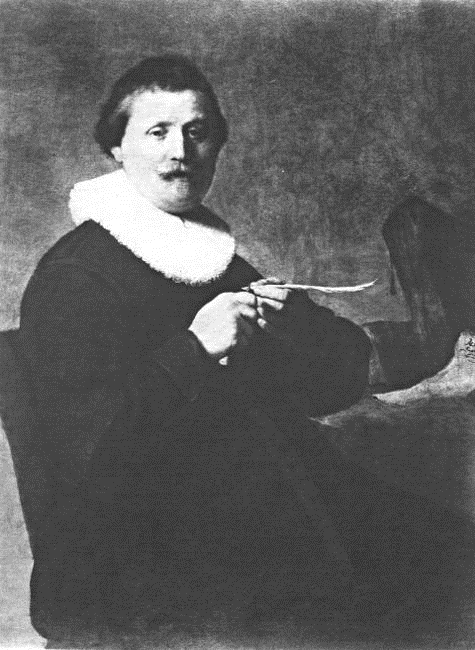
IN THE CASSEL GALLERY
COPPENOL – Portrait by Rembrandt
REMBRANDT
His Etchings
SIXMany people in considering Rembrandt think of him only as a master painter; they overlook the fact that he was also the leading etcher of his time. This monograph will take up briefly this part of the great artist’s work.
It is related of Hokusai, the Japanese artist, that he once said that he hoped to live to be very old, and that he might have time to learn to draw in such a way that every stroke of his pencil would be the expression of some living thing. That is exactly what Rembrandt managed to do in almost every one of his etchings. This is particularly true of the wonderful little etching of his mother. One critic says that on looking at this etching he was compelled to close his eyes for a moment, because of the tears that rose unbidden at sight of it. It would be hard to find anything more worthy of praise than this engraving. Every line expresses motherly kindness, sweetness, and thoughtfulness. Nothing could have been omitted; the etching is complete.
So skilful was Rembrandt as an etcher that the nobleness of his ideas and the depth of his nature are apt to be overlooked. His engravings are pervaded by his big, artistic personality and by his own ennobling influence. The artist’s soul spoke not only through the choice of subject, but found expression in every single detail. He showed a singular inventive power, originality of conception, and a great depth of understanding.
Among Rembrandt’s etchings were many wonderfully life-like portraits, biblical subjects, and landscapes. An interesting thing about all this work is that most of it was done between the years 1639 and 1661. After this Rembrandt seems to have renounced etching entirely. In these twenty years he produced his greatest works, on every one of which appears the impress of the genius of the man.



